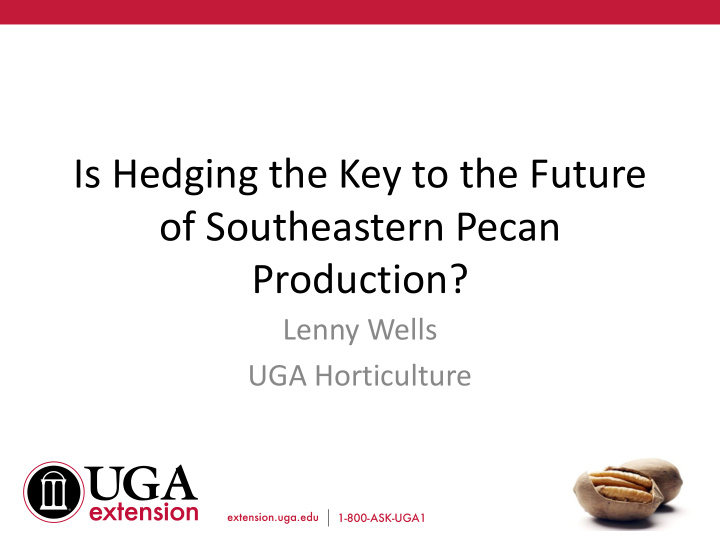



Is Hedging the Key to the Future of Southeastern Pecan Production? Lenny Wells UGA Horticulture
Cloud Cover Las Cruces, NM
Cloud Cover, Moree, New South Wales, Australia
Cloud Cover, Albany, GA
Every 4 th Row •
Every Other Middle
Mechanical Pruning: Direction • Hedgerow direction makes a difference. – Both sides of N-S oriented hedgerows receive sunlight. – Only south side of W-E oriented hedgerows receives sunlight.
Mechanical Pruning: Direction Wood and Stahmann, 2004
Hedge pruning effects on scab? Not hedged Hedged After hedge pruning, fresh growth is produced and grows throughout the season These leaves are susceptible to scab (susceptible cultivars) Could make it more challenging to manage scab? Consequently, fruit on hedged trees may have more severe scab However, an advantage may be hedged orchards are more open (more air movement, therefore conditions less conducive to scab) Also hedged trees are shorter providing opportunity for better fungicide coverage Clive Bock, USDA
Summary ~12-14 m (40-45 ft) Under the same fungicide regime hedge pruning cannot be said to increase or decrease scab severity in the canopy up to 40 ft (12.5 m) There is an increasing advantage to hedging as more of the fruit are within reach of effective fungicide coverage If trees are young (<40 ft, 12.5 m) there are advantages to maintaining this height on a hedging program Prevent scab developing in the canopy at heights >40-45 ft Overall yield and kernel quality will be less impacted by poorly controlled scab Removes scab in the upper canopy as a source of inoculum Clive Bock, USDA
Hedging Trial –Marshallville, GA Desirable trees 14 m (~46 ft) and hedged to 12-14 m (39-46 ft) o Planted 1996 o Hedged alternate rows - one side March 2013, other side March 2014 o (sampled trees hedged on West in 2013 and 2016, East in 2014) Hedged/Non- Thinned Hedged/non Hedged by Tree -Hedged Desirable Removal Sumner Not hedged Non-Hedged rows Hedged rows
Hedging Trial Yields 2000 Desirable 1500 1000 500 0 2013 2014 2015 2016 *No statistical diff. Hedged Non-Hedged Sumner 3000 2000 1000 0 2013 2014 2015 2016 Hedged Non-Hedged Tree Removal
Hedging Quality—Desirable Percent Kernel 59 a 58 a a a 57 a Percent Kernel (%) a b 56 Hedged 55 b Non-Hedged 54 53 52 51 2013 2014 2015 2016
Hedging Quality—Desirable Nut Size 50 a 49 b 48 47 Mean Nuts per lb. a 46 45 a 44 b b a a 43 42 41 40 39 2013 2014 2015 2016 Hedged Non-Hedged
Water Stress in Hedged vs. Non- Hedged Trees---2015 120 Mean Stem Water Potential (psi) 100 80 60 40 20 0 Hedged Non-Hedged 90 Mean Stem Water Potential (psi) 88 86 84 82 80 78 Hedged Non-Hedged
Water Stress in Hedged vs. Non- Hedged Trees---2016 180 Mean Stem Water Potential (psi) 160 140 120 100 80 h 60 nh 40 20 0 120 Mean Stem Water Potential (psi) 100 80 60 40 20 0 Hedged Non-Hedged
How close is too close? 30 X 30 --- 9 years old
Potential Yields of ‘Creek’ at Various Spacings Trees/acre 48.4 54.45 72.6 Year 30 X 30 20 X 40 20 X 30 4 336 378 504 5 480 540 720 6 720 810 1080 7 960 1080 1440 Cost/Acre of Tree Spading in Year 8: $960, $1040, and $1440 Potential gross* income/acre over 4 year period: $6240, $7020, and $9360 --Does not include cost of spraying, fertilization, irrigation, hedging, etc.
Tight Spacings/Hedging Not for Everybody • Expensive • Labor Intensive • Difficult Psychologically Safe Route: Plant 25 X 50 30 X 50 40 X 40 Avoid the following combination: Tight Spacing, Scab Susceptible Varieties, Poor air flow
Should You Be Hedging? • Positive: • Negative: – Better fungicide – Expensive coverage – Labor Intensive – Improved Quality/Size – Limit to number trees/acre – Reduced Water – Likely increased pest Stress pressure – Allows more trees – Allows more trees per acre per acre – Easier method of fruit thinning
Recommend
More recommend